IJCRR - 7(9), May, 2015
Pages: 66-70
Print Article
Download XML Download PDF
NANOTECHNOLOGY - ADVANCING THE FIELD OF BIOMEDICAL ENGINEERING
Author: Prajakta Kishore Kalangutkar
Category: Healthcare
Abstract:Biomedical Engineering is one of the most important fields in engineering as it deals with interfacing the human body with electronic devices. Thus the performances of these Biomedical devices need to meet the requirements. However the traditional devices lack in certain aspects due to the accessibility of complex structures. With the recent advances in Nanotechnology, a wide range of Biomedical devices are gaining a boom in development by overcoming the drawbacks of the traditional devices. The application of Nanotechnology in Biomedical engineering has given rise to a drug delivery system that directly targets the affected cell, a nano capsule with camera that can be swallowed by patient for diagnosing ailments and many more such applications that make the diagnosing and treatment much simpler and the complex structures accessible. This paper reviews the advancement of Biomedical applications due to the integration of Nanotechnology field
Keywords: Nanoparticles, Nanomanufacturing, Microbots, Biomarkers
Full Text:
INTRODUCTION
Nanotechnology is one of the most important emerging fields in medical sciences. In a broader sense, it is a field where the diverse fields of physics, chemistry, biology, materials science, and engineering converge at a scale ranging from 1 to 100 nanometers, essentially known as the nanoscale [3]. Nanotechnology is a science of understanding and controlling of atoms and molecules at nanoscale using a procedure called nanomanufacturing. The art of nanomanufacturing has brought about a revolution in the field of biomedical engineering where, the nano -materials and –devices are designed to interact with the body at sub-cellular level [1]. A wide range of biomedical applications have been benefited from nanotechnology, such as biosensors, drug and gene delivery, artificial cells, nanorobots for surgery, and many more. Most significant property of nanoparticles is the carbon strength, which is so tough that recently with a carbon nanotube a bullet proof T-shirt/vests was manufactured [2].
NANOTECHNOLOGY
Although nanotechnology seems to have gained a widespread interest in the recent years, the concepts behind nanoscience and nanotechnology are dated back to 1959 when physicist Richard Feynman delivered a talk entitled ?There‘s Plenty of Room at the Bottom at an American Physical Society meeting at the California Institute of Technology (CalTech). However, the term ‘nanotechnology‘ was coined over a decade later, by Professor Norio Taniguchi, in his explorations of ultraprecision machining [3]. In his talk, Richard Feynman also mentioned about a suggestion made by his friend, Albert R. Hibbs regarding micromachines. Hibbs quoted that, “… it would be interesting in surgery if you could swallow the surgeon. You put the mechanical surgeon inside the blood vessel and it goes into the heart and “looks’’ around … It finds out which valve is the faulty one and takes a little knife and slices it out. Other small machines might be permanently incorporated in the body to assist some inadequately- functioning organ.” - Richard Feynman [4]. The possibility that was considered by Richard and Hibbs, almost 55 years ago is becoming a reality now. In 1981 as the scanning tunneling microscope developed, the evolution of nanotechnology began to turn out today as a revolution in the fields of engineering and technology, imaging, measuring, modeling, and manipulating matter nanoscale [3].
NANOMATERIALS
Today researchers worldwide are manufacturing nanomaterials to make new products and applications, ranging from medical devices and drugs, to strong and lightweight materials that reduce fuel costs for cars and planes. Based on the shapes and dimensions, different types of nanomaterials are named, such as particles, tubes, wires, films, flakes, or shells that have one or more nanometer-sized dimension. Producing nanomaterials for use in biomedicine is a challenging task. However the recent advances in Nanotechnology-based drug carriers and materials have yielded more medical benefits especially the field of cancer therapy by improve the solubility of poorly soluble drugs, circulate in blood stream for longer time without being recognized by macrophages, as well as controlled release of drugs at an expected rate in the desired area. Nanocarrier systems can be designed to interact with target cells and tissues or respond to stimuli in well-controlled ways to induce desired physiological responses [3]. Figure 1 shows the different types of nanomaterials used in nanotechnology [5]
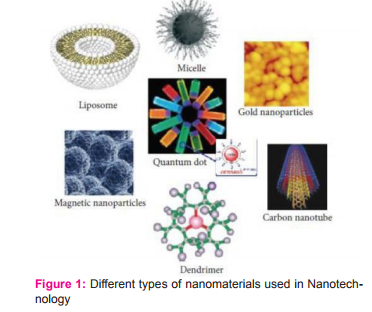
NANOTECHNOLOGY IN BIOMEDICAL ENGINEERING
The Biomedical applications of Nanotechnology are basically a convergence between the two rapidly growing fields of Nanotechnology and Biotechnology. Nanotechnology deals with manufacturing, investigation and utilization of systems at nanoscale and Biotechnology deals with metabolic process with microorganisms. These interdisciplinary disciplines are also used to make atomic-scale machines by imitating or incorporating biological systems at the molecular level, or building tiny tools to study or change natural structure properties atom by atom. Thus these fields have helped in innovation and creation of many powerful tools that are now used in Biomedical applications. The application of Nanotechnology in Biomedical mainly involves the production of the nano -materials and –devices are designed to interact with the body at sub-cellular level [1].
NANOTECHNOLOGY IN MEDICINE:
The medical application of nanotechnology is widely termed as nanomedicine. It ranges from medical applications of nanomaterials to nanoelectronics biosensors. The research and development of nanomedicine is broadly divided into three factors. The first impact of nanoscience on medicine is evolutionary. A second development is explicit and revolutionary, emphasizing great advances to be gained by radical new nanotechnology approaches. A third source of nanotechnology on medicine is indirect through the development and application of ever-improving nanotools and devices based on smaller and more precise technologies. These technologies impact research, diagnostics and therapeutics [3]. Most of the nanotechnology applications in medicine are widespread. It starts with the identification and validation and is extended up to the treatment. Figure 2 shows the various applications of Nanotechnology in Biomedical applications:
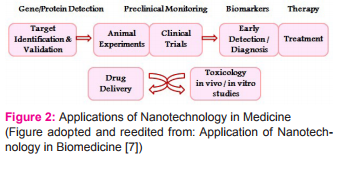
REVIEWING NANOTECHNOLOGY IN BIOMEDICAL APPLICATIONS
Many medical nanotechnology applications are still in their infancy. However, an increasing number of products is currently under clinical investigation and some products are already commercially available, such as surgical blades and suture needles, contrast-enhancing agents for magnetic resonance imaging, bone replacement materials, wound dressings, anti- microbial textiles, chips for in vitro molecular diagnostics, microcantilevers, and microneedles [6], as depicted in Figure 3 [9].
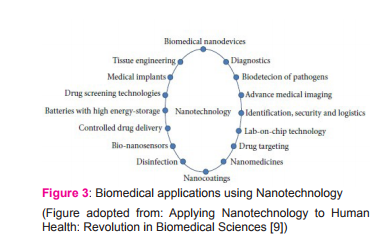
PillCam:
With the introduction of PillCam by “ GIVEN IMAGING” in 2001, the first step towards application of nanotechnology in medicine was taken [10]. The PillCam is a capsule, ideally the size of a normal pill, contains a light and camera which is to be swallowed by the patient. Images beamed wirelessly from the capsule can be analyzed and used for diagnostic purposes, thus replacing procedures like the traditional endoscopy, in which a flexible tube containing a flashlight and camera is inserted into the digestive tract. The PillCam, is ideal for use in the passageways of the gastrointestinal system since it can be swallowed.
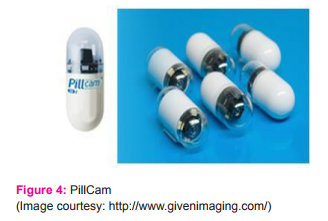
Drug Delivery:
Since 1960, researchers have been developing drug delivery systems that can directly target the affected regions. Due to the small size of nanoparticles, they are proving out to be suitable for such drug delivery systems. Based on the type of particle, the active substance of nanoparticle can be encapsulated or attached to the surface. This means that even if they dissolve poorly in water, they can be transported in an aqueous solution, such as blood, and are better protected against degradation by enzymes, for example. A suitable coating on the nanoparticle can prevent identification and removal by the immune system [12]. The nanoparticles Dendrimers are commonly used for drug delivery system due to their well defined size, shape, molecular weight and monodispersity [13]. Although they are complicated to synthesize, the advantage of dendrimers is that their synthesis results in a single molecular weight rather than distribution of sizes [14].
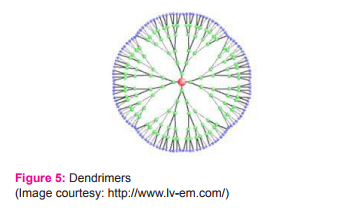
Figure 5: Dendrimers
(Image courtesy: http://www.lv-em.com/)
Biomarkers
Nanoparticles can be used for both quantitative and qualitative in vitro detection of tumour cells. They enhance the detection process by concentrating and protecting a marker from degradation, in order to render the analysis more sensitive. The research results have shown that the fluorescent nanospheres provided a sensitivity of 25 times more than that of the conjugate streptavidin-fluorescein [1]. Many kinds of nanomaterials will be used to help researchers develop prototype nanotechnology-based sensors for measurement of biomarkers. Materials like metal nanoparticles (gold, silver), semiconductor nanoparticles, and enzyme-loaded carbon nanotubes (CNTs) may be used to amplify biomarker signals.
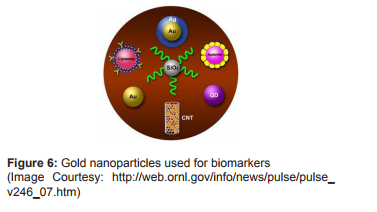
Figure 6: Gold nanoparticles used for biomarkers (Image Courtesy: http://web.ornl.gov/info/news/pulse/pulse_ v246_07.htm)
Microbots:
Microbots are extremely small devices that can work inside the human body to help fight diseases. One of the microbot being developed resembles the flagella – a spiral shaped tail that helps bacterium to swim. These artificial bacterial flagella (ABFs) are about half the diameter of a human hair and are made using computer chip technology. Robots this small are called Nanobots, much smaller than bacteria. A magnetic head is attached to the ABF, so that, through a magnetic field, can be made to rotate, and move forward and forward. Once it is directed to a precise location, the robot could deliver medicine that destroys tumors [16]. In addition to cancer treatment, microbots are also being considered potentially useful for other medical purposes. Diabetes patients have to test their blood multiple times daily to ensure that their glucose levels are stable. Using nanobots would enable doctors to receive data from many different locations simultaneously throughout the body and allow for a more continuous monitoring of blood sugar levels without the pain and inconvenience of selftesting [17].
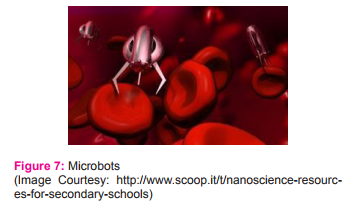
Cancer Detection and Treatment:
The NCI Alliance for Nanotechnology in Cancer states that, In the fight against cancer, half the battle is won based on early detection. Nanotechnology research is contributing to improved cancer survival rates through advances in screening, diagnosis, monitoring, and treatment. In the traditional methods of chemotherapy, it was found that 99% of the times the drug would not reach the target cell. Nanotechnology has proved its efficiency in early detection of the cancerous cells as well as treatment of cancer. Nanoparticles also carry the potential for targeted and time-release drugs. A potent dose of drugs could be delivered to a specific area but engineered to release over a planned period to ensure maximum effectiveness and the patient’s safety. These treatments aim to take advantage of the power of nanotechnology and the voracious tendencies of cancer cells, which feast on everything in sight, including drug-laden nanoparticles. One experiment of this type used modified bacteria cells that were 20 percent the size of normal cells. These cells were equipped with antibodies that latched onto cancer cells before releasing the anticancer drugs they contained. Another used nanoparticles as a companion to other treatments. These particles were sucked up by cancer cells and the cells were then heated with a magnetic field to weaken them. The weakened cancer cells were then much more susceptible to chemotherapy [19]. Figure 8 illustrates the use of nanoparticles for cancer therapy.
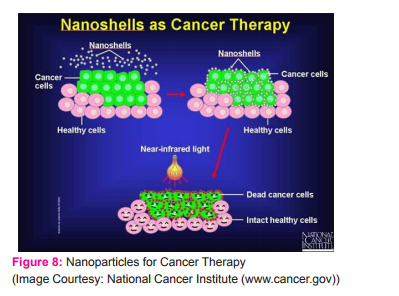
DISCUSSION
In the field of Biomedical, nanotechnology is a boon since extremely small devices such as the nanobots or the PillCam can be created to help cure people faster and without the side effects that other traditional drugs have. The traditional drugs have a drawback that they dissolve poorly in water; however the drugs developed with the help of nanotechnology have the ability to transport easily in an aqueous solution, such as blood. You will also find that the research of nanotechnology in medicine is now focusing on areas like tissue regeneration, bone repair, immunity and even cures for such ailments like cancer, diabetes, and other life threatening diseases. Although today Nanotechnology is a fast growing field, there are some challenges associated with using Nanotechnology in Biomedical engineering which need to be taken care of. Since these particles are very small, problems can actually arise from the inhalation of these minute particles, much like the problems a person gets from inhaling minute asbestos particles [20]. If we change the structure of material on the nano level without understanding the potential impact on the nanoscale, we risk creating a whole world of materials that have atoms that actually do not fit together cohesively [21]. Presently, nanotechnology is very expensive and developing it can cost a lot of money. It is also pretty difficult to manufacture, which is probably why products made with nanotechnology are more expensive [20].
CONCLUSION
Although the advances of Nanotechnology in Biomedical field are advancing at a comparatively slower rate, however the revolution in Nanotechnology has made it possible to overcome the drawbacks of the traditional devices. Thus this manuscript reviews the advancement of Biomedical applications due to the integration of Nanotechnology field.
ACKNOWLEDGEMENT
Author acknowledges the immense help received from the scholars whose articles are cited and included in references of this manuscript. Author is also grateful to authors / editors / publishers of all those articles, journals and books from where the literature of this article has been reviewed and discussed.
References:
1. Herbert Ernest and Rahul Shetty, “Impact of Nanotechnology on Biomedical Sciences: Review of Current Concepts on Convergence of Nanotechnology With Biology”, Submitted: March 26th, 2005.
2. Shalini Singh, “Nanostructures: Enhancing Potential Applications in Biomedicals”, Journal of Biomaterials and Nanobiotechnology, 2013, Vol.4, No.1, Article ID: 26835.
3. Kalangutkar, Prajakta Kishore. “The Evolution of Nanomedicine with the Re-Evolution of Nanotechnology.”
4. There’s Plenty of Room at the Bottom- http://www.zyvex. com/nanotech/feynman.html.
5. Weili Qiao, BochuWang, YazhouWang, Lichun Yang, Yiqiong Zhang, and Pengyu Shao “Cancer Therapy Based on Nanomaterials and Nanocarrier Systems”, Journal of Nanomaterials, Volume 2010, Article ID 796303.
6. B.Roszek, W.H. de Jong and R.E. Geertsma, “Nanotechnology in medical applications: state-of the-art in materials and devices”, RIVM report 265001001/2005
7. Rajshri M.Navalakhe and Tarala D.Nandedkar, “Application of Nanotechnology in Biomedicine”, Indian Journal of Experimental Biology, Feb 2007,Vol.54, pp. 160-165.
8. Biomedical Application of Nanotechnology: http://www. ece.gatech.edu/
9. Siddhartha Shrivastava and Debabrata Dash , “Applying Nanotechnology to Human Health Revolution in Biomedical Sciences”, Journal of Nanotechnology,Vol.2009, Article ID 284702.
10. YaleScientific: http://www.yalescientific.org/2013/02/ microbots-using-nanotechnology-in- medicine/
11. Given Imaging: http://www.givenimaging.com/, visited on 30/12/2014.
12. Nanotechnology medical applications – Research at the University of Maryland.
13. Anirudha Malik, Sudhir Chaudhary, Garima Garg and Avnika Tomar, “Dendrimers: A Tool for Drug Delivery”, Advances in Biomedical Research,2012, Vol. 6, issue 4, pp. 165-169.
14. Low Voltage Electron Microscope - http://www.lv-em. com/news-and-events/lvem5-desktop- tem-used-to-imagedendrimers
15. Oak Ridge National Laboratory: http://web.ornl.gov/info/ news/pulse/pulse_v246_07.htm, visited on 26/12/2014.
16. Medical Discovery News: http://www.medicaldiscoverynews.com/shows/255-microbots.html, visited on 22/12/2014.
17. Yale Scientific: http://www.yalescientific.org/2013/02/ microbots-using-nanotechnology-in- medicine/, visited on 22/12/2014.
18. Scoop.It! http://www.scoop.it/t/nanoscience-resourcesfor-secondary-schools, visited on 2/1/2015.
19. http://health.howstuffworks.com/medicine/modern-technology/gold-nanotech1.htm, visited on 29/12/2014.
20. Introduction to Nanotechnology: http://nanogloss. com/nanotechnology/advantages-and - disadvantages-of-nanotechnology/#ixzz3OUXqd79a, visited on 29/12/2014.
21. Introduction to Nanotechnology: http://nanogloss. com/nanotechnology/the-potential- disadvantages-of-nanotechnology/#ixzz3OUbIWuwF, visited on 29/12/2014.
|






 This work is licensed under a Creative Commons Attribution-NonCommercial 4.0 International License
This work is licensed under a Creative Commons Attribution-NonCommercial 4.0 International License